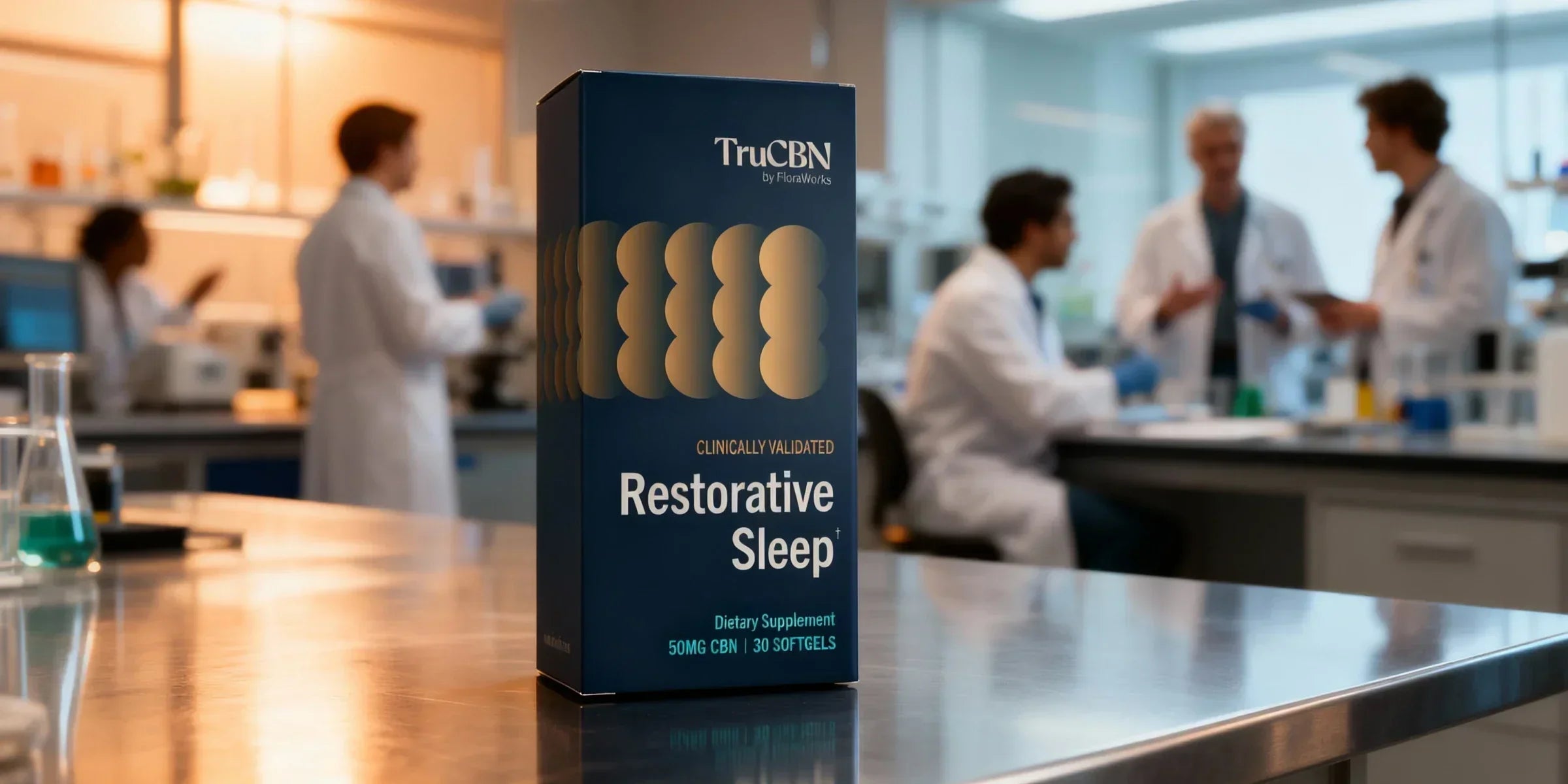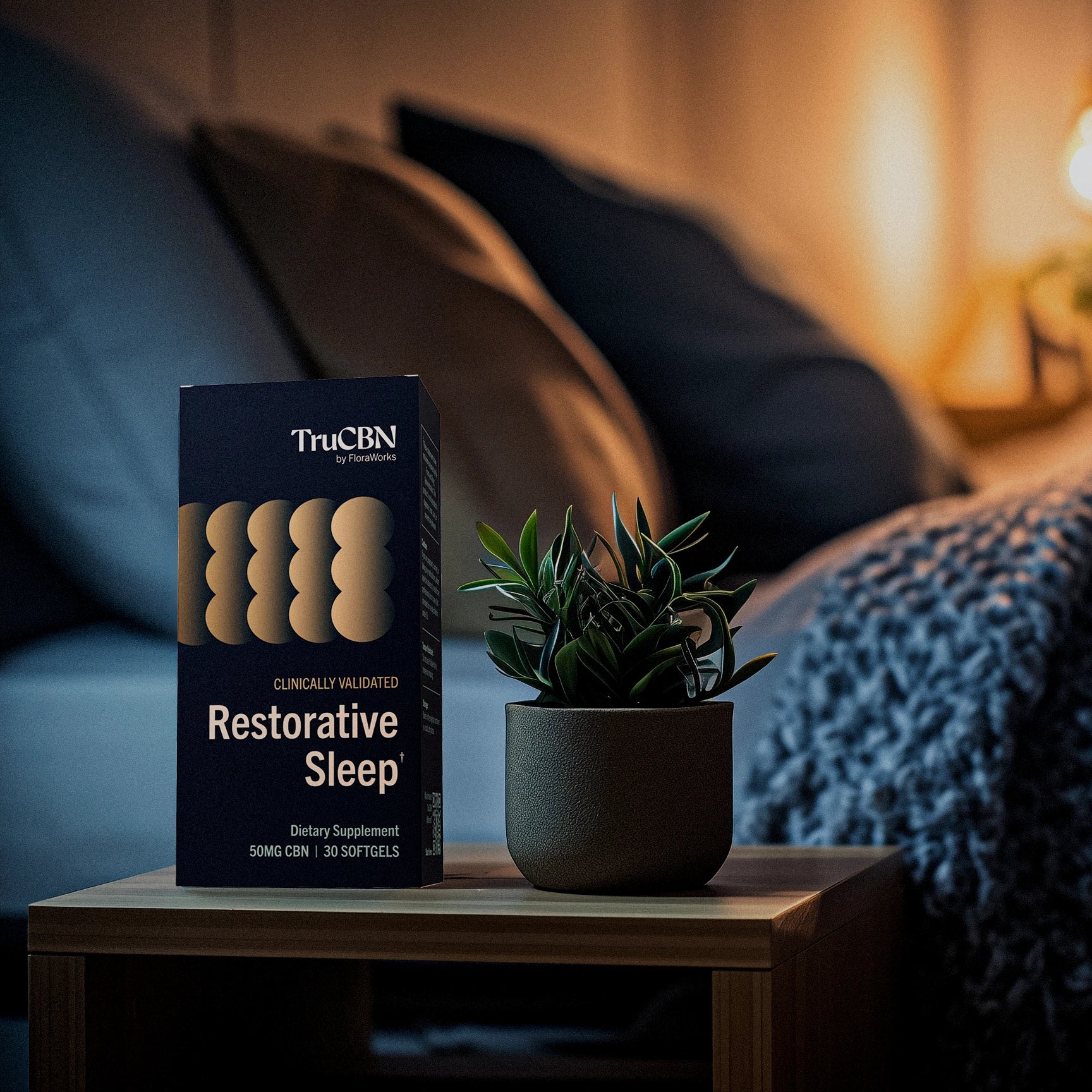TruCBN for Restorative Sleep: Inside the Peer-Reviewed Trial

If you’ve been searching for a melatonin‑free way to improve your sleep, the TruCBN sleep study is worth a closer look. In July 2024, a randomized, double‑blind, placebo‑controlled trial was published in the journal Pharmaceuticals evaluating TruCBN at multiple doses in adults with sleep disturbance. Participants taking TruCBN reported significant improvements in sleep quality compared to placebo, with a favorable safety profile. Notably, 50 mg showed the strongest and most consistent improvements reported in brand summaries and reflected in the peer‑reviewed data.
In this guide, we’ll break down what the study tested, how it was designed, which outcomes improved, how TruCBN compared with melatonin, and practical steps for trying TruCBN Softgels yourself—starting with 50 mg. The goal: give you a clear, evidence‑forward view so you can decide if TruCBN fits your routine.
What Is TruCBN and Why Is It Different?
TruCBN is a standardized, highly purified form of CBN (cannabinol), a plant‑derived compound. It’s formulated for consistency and tested for identity and potency. TruCBN Softgels are melatonin‑free, offering a non‑hormonal option for adults who want better sleep quality without using melatonin. For some people, that matters. Melatonin can be helpful, but it’s a hormone, and some users report next‑day grogginess or inconsistent effects. The TruCBN sleep study included melatonin as an active comparator to put results in context.
The Peer‑Reviewed TruCBN Sleep Study at a Glance
- Journal: Pharmaceuticals (peer‑reviewed), July 2024
- Design: Randomized, double‑blind, placebo‑controlled; active comparator included
- Participants: U.S. adults (21+) reporting sleep disturbance who wanted better sleep
-
Arms:
- TruCBN 25 mg softgel
- TruCBN 50 mg softgel
- TruCBN 100 mg softgel
- Melatonin 4 mg softgel (active comparator)
- Placebo
- Duration: 4 weeks of nightly use with weekly assessments, plus follow‑up
- Primary outcome: PROMIS Sleep Disturbance 8a (validated patient‑reported measure; lower scores = better sleep)
- Exploratory outcomes: PROMIS Stress 4a, PROMIS Anxiety 4a, WHO‑5 Well‑Being, PEG pain measure
- Safety: Adverse events monitored; products verified by independent lab prior to use
Key Results: What Improved with TruCBN
- Sleep quality improved versus placebo across the TruCBN groups. Participants reported meaningfully lower sleep disturbance scores over the study period.
- 50 mg TruCBN stood out. In brand summaries and patterns reflected in the peer‑reviewed data, the 50 mg arm showed particularly strong improvements in sleep quality.
- Exploratory findings: 100 mg showed a notable decrease in stress versus placebo in exploratory analysis.
- Versus melatonin: TruCBN doses performed comparably to 4 mg melatonin on the primary sleep outcome (no statistically significant differences between them), indicating TruCBN offers a clinically studied, melatonin‑free alternative for improving sleep quality.
Safety and Tolerability
- Overall profile: Mild to moderate side effects across all groups; no serious adverse events reported.
- Frequency: Side effect rates did not differ significantly between active arms and placebo.
- Common mild events included transient grogginess/drowsiness or headache at low frequencies. No emergency or non‑emergency medical care was required due to study products.
Why This Study Matters
- Peer‑reviewed: External experts evaluated the methods and findings before publication.
- Rigorous design: Randomized, double‑blind, placebo‑controlled with an active comparator.
- Real‑world relevance: Decentralized trial. Participants used products at home as they would in daily life.
- Dose insights: Multiple TruCBN serving sizes were studied, and 50 mg emerged as a strong, practical starting point.
TruCBN vs. Melatonin: What the Data Suggests
- Sleep improvements were comparable between TruCBN arms and 4 mg melatonin on the primary outcome.
- For adults seeking a non‑hormonal, melatonin‑free option—with peer‑reviewed evidence—TruCBN provides a compelling alternative that demonstrated clinically observed benefits.
Understanding the Measures (Plain English)
- PROMIS Sleep Disturbance 8a: A short, validated questionnaire where lower scores mean better sleep. Participants reported their weekly sleep experience, and the study compared changes between groups over time.
- PROMIS Stress and Anxiety: Brief tools capturing how often stress or anxiety symptoms occur.
- WHO‑5: A five‑item well‑being scale. Higher scores reflect better mood and well‑being.
- PEG: A quick assessment of pain intensity and how much pain interferes with daily activities.
Who Might Consider TruCBN
- Adults who want a melatonin‑free path to better sleep quality
- People who value standardized dosing and peer‑reviewed evidence
- Anyone who prefers a simple nightly routine: 1 softgel, 1–2 hours before bed
Who Should Be Cautious
- Those who are pregnant or breastfeeding (excluded from the study)
- Anyone with a medical condition or on prescription medications—talk with your clinician first
How to Start: A Practical, Evidence‑Informed Routine
- Start at 50 mg nightly. In the peer‑reviewed study, the 50 mg serving showed the strongest and most consistent improvements in sleep quality. Take one TruCBN 50 mg Softgel 1–2 hours before bedtime.
- Stay consistent for several weeks. Participants reported weekly changes, and consistency helps you see your pattern.
- Track your nights. Note bedtime, wake time, awakenings, and how you feel in the morning. Small changes add up.
- Adjust if needed. If you’re sensitive, you may consider 25 mg. If you’re not noticing changes after a consistent trial, speak with your healthcare provider about options.
What We Can—and Can’t—Say
- What we can say: In a peer‑reviewed, randomized, controlled trial, TruCBN improved sleep quality compared with placebo. Safety signals were favorable, and 50 mg showed a particularly strong pattern of improvement. TruCBN performed comparably to melatonin on the primary sleep outcome.
- What we can’t say: TruCBN is not a treatment for any disease, and individual responses vary. The study assessed several weeks of use; longer‑term outcomes weren’t evaluated in this trial.
How the Study Was Conducted (For the Curious)
- Randomization and blinding reduce bias. Neither participants nor researchers knew which product a participant received during the study.
- Statistical approach: Analyses compared change over time between groups using mixed‑effects models, adjusting for relevant factors like age and sex.
- Registration and oversight: The study was registered on ClinicalTrials.gov and approved by an independent IRB.
- Product verification: Independent lab testing confirmed identity and potency before products were shipped to participants.
Limitations to Keep in Mind
- Self‑reported outcomes. The study used validated questionnaires but did not include lab‑based sleep measures like polysomnography.
- Decentralized format. Real‑world relevance is high, but it relies on participant adherence and survey completion.
- Time frame. The trial evaluated several weeks, not months; longer‑term effects require future research.
Putting the Evidence to Work in Your Routine
If you’re melatonin‑sensitive or simply prefer a non‑hormonal approach, TruCBN offers a clinically studied alternative with a clear starting point: 50 mg nightly, taken 1–2 hours before bed. Combine it with simple sleep habits—dim lights in the evening, a wind‑down window, and a consistent bedtime—to give yourself the best chance of success. If you have questions about your situation or medications, your healthcare provider can help you personalize the plan.
Sleep Better Tonight with TruCBN Softgels
- Buy TruCBN Softgels
- Read answers to common questions in our FAQs
FAQ
Q: Why start with 50 mg?
A: In the peer‑reviewed study, 50 mg TruCBN showed the strongest and most consistent improvements in sleep quality. It’s a practical starting point for most adults. Stay consistent for several weeks, then reassess.
Q: How soon will I notice changes?
A: Participants reported weekly changes. Some people notice improvements sooner; others need consistent use for several weeks. Track your sleep and how you feel in the morning.
Q: How does TruCBN compare with melatonin?
A: On the primary sleep measure, TruCBN doses performed comparably to 4 mg melatonin, offering a melatonin‑free alternative with clinically observed benefits.
Q: Will TruCBN make me feel “high”?
A: The study did not report psychoactive effects. Side effects were mild and similar to placebo. If you have concerns, discuss them with your clinician.
Q: Can I combine TruCBN with other sleep aids?
A: The study evaluated TruCBN and melatonin separately. If you’re considering combining products, speak with your healthcare provider first.
Q: Where can I read the full study?
A: You can read the original study here, published in the journal Pharmaceuticals.





